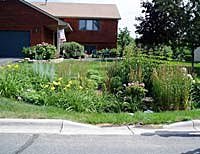Rain Gardens: A Solution for Wet Yards
By Marsha Goldberg, Fairfax Master Gardener
A River Runs Through It, by Norman MacLean, is a great read, but it also aptly describes my yard during a rainstorm. Unfortunately, our house sits at the low end of the neighborhood. Every time it rains, water from our neighbors’ yards runs down a gentle slope until it ends at a storm drain near our home. Over the years, this water flow eroded more and more of our yard, resulting in a deep rut and washing away precious seeds and soil from the beds it encountered along the way. At first, the only approaches we could think of to fix the problem were expensive and/or labor intensive. But then I discovered rain gardens.
 By definition, a rain garden is a landscaped area specifically designed to collect rainfall and storm-water runoff. A rain garden is not only beautiful but beneficial to the environment as well. In addition to causing damage to neighborhood backyards, rain runoff causes damage to our water supply. As runoff passes over sidewalks, streets and hardscapes, it picks up debris, such as gravel and motor oil. It sweeps up fertilizers, pesticides and pet waste from lawns, all of which then flow into storm drains and enter the local water system. Even runoff from roofs can contribute to this problem. In addition, the excess water flowing into streams causes their banks to erode.
By definition, a rain garden is a landscaped area specifically designed to collect rainfall and storm-water runoff. A rain garden is not only beautiful but beneficial to the environment as well. In addition to causing damage to neighborhood backyards, rain runoff causes damage to our water supply. As runoff passes over sidewalks, streets and hardscapes, it picks up debris, such as gravel and motor oil. It sweeps up fertilizers, pesticides and pet waste from lawns, all of which then flow into storm drains and enter the local water system. Even runoff from roofs can contribute to this problem. In addition, the excess water flowing into streams causes their banks to erode.
Rain gardens help combat these problems. The plants and soil in rain gardens clean pollutants from the water as it seeps into the ground and evaporates back into the atmosphere. Rain gardens allow 30 percent more water to soak into the ground. Native plants are a smart choice for rain gardens because they can tolerate the wet conditions and local weather so, in addition, the native plants in a rain garden can beautify a yard and create a habitat for birds, butterflies and beneficial insects.
 If rainwater runs through your yard, or if rain results in standing water, consider installing a rain garden. A professional can do it, or you can do it yourself, if you are willing to put in the labor required for digging and planting. Many state cooperative-extension agencies offer free publications that provide technical details, but the final decisions about appearance, size and construction techniques can vary, so you can create a rain garden that suits your preferences in garden design.
If rainwater runs through your yard, or if rain results in standing water, consider installing a rain garden. A professional can do it, or you can do it yourself, if you are willing to put in the labor required for digging and planting. Many state cooperative-extension agencies offer free publications that provide technical details, but the final decisions about appearance, size and construction techniques can vary, so you can create a rain garden that suits your preferences in garden design.
You will need to follow the guidelines for the shape, size and location of your garden and to calculate the slope of the ground and where you need to capture the flow. You will also need to consider the type of soil in your yard. If your soil has a high-clay content, as is typical in our area, it may not absorb the water quickly enough to be effective. In that case, you can amend the soil with sand and compost. The cooperative extension guidelines can help you with these details.
Once you have prepared the area for your rain garden, you can begin to choose plants. You will want plants that tolerate wet conditions as well as dry spells and, as always, plants that are non-invasive. You can follow typical landscaping principles, choosing a variety of species, so that you have varied heights and year-round color and interest. The state cooperative extension agencies can help with plant suggestions, too. Just be sure to consult a guide from a state that is in the same hardiness zone as your property, so you know the plants will do well in your area.
Native Plants for Northern Virginia available online
Plant Nova Natives is an excellent resource
Native Plants for Wildlife Habitat and Conservation; Chesapeake Bay Watershed from the U.S. Fish and Wildlife Service.
You can also get templates for designing the layout of your plants from the Low Impact Development Center, part of the National Fish and Wildlife Foundation.
Make this year the year you install a rain garden. It will not only add interest to your yard, but will provide significant benefit to the environment as well.
More References and Resources
Urban Water-Quality Management: Rain Garden Plants, Andruczyk, M., Swanson, L., Fox, L., French, S., & Gilland, T. Publication 426-043. Virginia Cooperative Extension, Virginia Polytechnic Institute and State University, 2015, Blacksburg, VA
Rain Garden Design Templates, Low Impact Development Center Author. National Fish and Wildlife Foundation, Beltsville, MD
Planting Your Rain Garden, North Carolina Cooperative Extension, Author, North Carolina State University, Raleigh, NC
Rain Gardens. Fact sheet FS513, Obropta, C., Sciarappa, W. & Quinn, V. Ph.D. NJ Agricultural Experiment Station, Rutgers Cooperative Extension and Research, New Brunswick, NJ 2006
Rain Garden Design and Construction: A Northern Virginia Homeowner’s Guide, The Northern Virginia Soil and Water Conservation District.. Author. Fairfax, VA